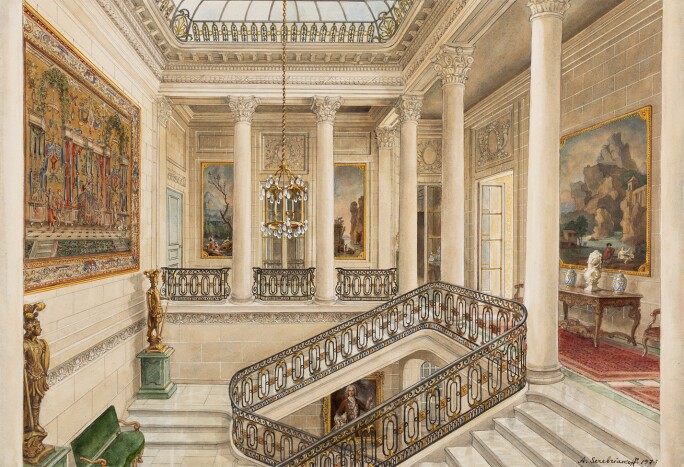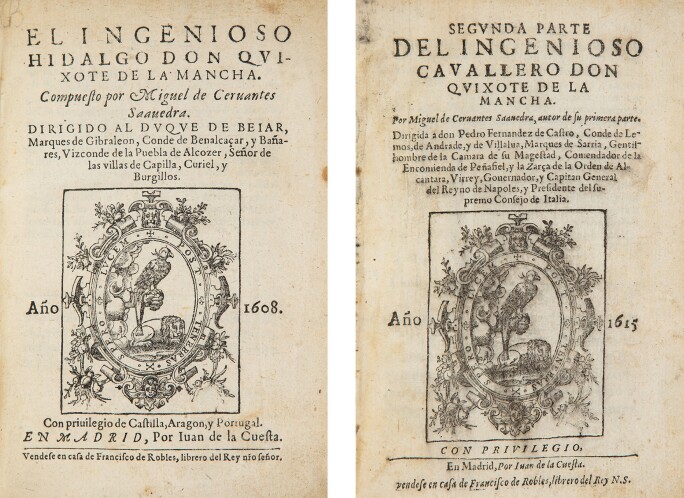J orge Ortiz Linares (1894 – 1965) was the Bolivian ambassador to Paris, a fitting owner for Don Quixote, a book so deeply rooted in the story of “the New World.” He was the son in law of Simón I. Patiño, also known as “The Tin King” or "The Andean Rockefeller", and one of the world’s wealthiest men of the early 20th century. The apartment he shared with his wife Graciela Patiño on 34 Avenue Foch during his long ambassadorship became one of the centres of artistic and high-society life.

c Adagp, Paris, [1974].c Photo Julien Gremaud
He passionately collected rare books and manuscripts from early ages, focusing on two areas: his native Hispanic-American world and French literature, in time building one of the great libraries of the age. French literature of the Grand Siècle is marked here with magnificent editions of Guillaume de Lorris, Rabelais, Montaigne, Corneille, Descartes, Pascal, Racine, Molière, La Fontaine and La Rochefoucauld.
The shadow of two of the great booksellers of the 20th century hang behind this elegant, airy collection: Maggs of London for the Hispanic books, and the unforgettable Pierre Berès, for whom Jorge Ortiz Linares was one of the most loyal and secret of customers.
The most recent chapter in the history of his copy of Don Quixote begins in London almost a century ago, in Maggs, bookseller to the Kings. In the early 1930s a young man – already a passionate collector, but unknown to the booksellers at the time – walked through the door of the shop for the very first time requesting to buy great editions of Don Quixote. He left empty handed and was put on the waiting list.
El Ingenioso hidalgo Don Quixote. Madrid, 1608 et 1615. 2 vol. in-8. Superbe ex. en rel. uniforme du XVIIIe
El Ingenioso hidalgo Don Quixote. Madrid, 1608 et 1615. 2 vol. in-8. Superbe ex. en rel. uniforme du XVIIIe
A few years later, the phone rang at the Parisian mansion on 34 Avenue Foch. It was the same voice from Maggs: “We have a copy for you, Sir”. Ortiz crossed the Channel by plane and returned to Maggs to buy these books on December 21, 1936. That same day, he also purchased the very rare original edition of the Novelas of 1613, bound for Jérôme II Bignon (1627-1697), Grand Master of the King’s Library. One of the great books collection of the 20th century was born.
“These books may only look like “old” books, a little shrivelled. But the editions are so rare that collectors, amateurs, experts and booksellers know that these copies will only pass through their hands once in their lifetime. These texts are part of what Goethe called in 1827 the Weltliteratur, that is to say works that everyone knows, that everyone experiences, that everyone has heard of.”
Jean-Baptiste de Proyart
Expert Voices: Jean-Baptiste de Proyart on The Ortiz Collection
Auction Highlights
- Jorge Ortiz Linares
- Simon Patiño
- Graciela Patiño de Ortiz Linares
-
 Jorge Ortiz LinaresJorge Ortiz Linares (1894-1965) was a Bolivian diplomat, a gentleman of elegance and culture, symbolic of an era. His tastes led him towards rare and precious books, while my mother preferred French silverware. They shared a love of paintings, furniture, carpets and bronze objects, which accompanied them throughout their lives (George Ortiz). Jorge Ortiz Linares began as Civil Attaché to the Bolivian Legation in late 1925. He then served as Second Secretary, First Secretary and Advisor until 1941. He was appointed Envoy Extraordinary and Minister Plenipotentiary of Bolivia to France from June 1947 to October 1948. He then held the same functions in Belgium and the Netherlands, while retaining his Parisian residence. In 1951, he was appointed Special Advisor by the Bolivian Embassy in Paris and was decorated with the Legion of Honor. He received military honors at his funeral in Paris in June 1965.
Jorge Ortiz LinaresJorge Ortiz Linares (1894-1965) was a Bolivian diplomat, a gentleman of elegance and culture, symbolic of an era. His tastes led him towards rare and precious books, while my mother preferred French silverware. They shared a love of paintings, furniture, carpets and bronze objects, which accompanied them throughout their lives (George Ortiz). Jorge Ortiz Linares began as Civil Attaché to the Bolivian Legation in late 1925. He then served as Second Secretary, First Secretary and Advisor until 1941. He was appointed Envoy Extraordinary and Minister Plenipotentiary of Bolivia to France from June 1947 to October 1948. He then held the same functions in Belgium and the Netherlands, while retaining his Parisian residence. In 1951, he was appointed Special Advisor by the Bolivian Embassy in Paris and was decorated with the Legion of Honor. He received military honors at his funeral in Paris in June 1965. -
 Simon PatiñoSimon Patiño (1860-1947), "the King of Tin", built his empire with his wife Albina Rodríguez. They were married in 1889 in Oruro, Bolivia. He was 28 years old and she was 16. They had five children: René, Antenor, Graciela – the future Madame Jorge Ortiz Linares – Elena and Luzmila, who all received a European education.
Simon PatiñoSimon Patiño (1860-1947), "the King of Tin", built his empire with his wife Albina Rodríguez. They were married in 1889 in Oruro, Bolivia. He was 28 years old and she was 16. They had five children: René, Antenor, Graciela – the future Madame Jorge Ortiz Linares – Elena and Luzmila, who all received a European education. -
 Graciela Patiño de Ortiz LinaresJorge Ortiz Linares was born in Sucre, Bolivia in 1894. His father, Don José Maria Ortiz y Prudencio married Doña Elena de Linares Lizarazu de Beaumont y Navarra Romero. Five children were born from this union: José, Julia, Jorge, Elena and René. The Ortiz Linares family left the wild highlands, the fragrant valleys of Cinti and the streets of the white city for Europe. The children did their studies in Switzerland and Paris. In 1914, they took refuge in Barcelona before going back to Sucre in 1918. Simon Patiño lived in a private mansion on the avenue Foch in Paris. In spite of their age difference, Simon Patiño and Jorge Ortiz Linares – heir to a line of aristocrats from Potosi and Chuquisaca - developed a relationship of mutual respect and friendship. Jorge Ortiz Linares married Graciela in 1926. Simon Patiño gave them a home near his own, at 34 avenue Foch. George (1927) and Jaime (1930) were born from this marriage.
Graciela Patiño de Ortiz LinaresJorge Ortiz Linares was born in Sucre, Bolivia in 1894. His father, Don José Maria Ortiz y Prudencio married Doña Elena de Linares Lizarazu de Beaumont y Navarra Romero. Five children were born from this union: José, Julia, Jorge, Elena and René. The Ortiz Linares family left the wild highlands, the fragrant valleys of Cinti and the streets of the white city for Europe. The children did their studies in Switzerland and Paris. In 1914, they took refuge in Barcelona before going back to Sucre in 1918. Simon Patiño lived in a private mansion on the avenue Foch in Paris. In spite of their age difference, Simon Patiño and Jorge Ortiz Linares – heir to a line of aristocrats from Potosi and Chuquisaca - developed a relationship of mutual respect and friendship. Jorge Ortiz Linares married Graciela in 1926. Simon Patiño gave them a home near his own, at 34 avenue Foch. George (1927) and Jaime (1930) were born from this marriage.
Spanish Literature
This is unquestionably the most remarkable array of works by Miguel de Cervantes Saavedra which has been brought to the market for many years. The great Spanish writer is represented by the second edition published in Lisbon in 1605 by Jorge Rodriguez, who was the first to present the iconic image of Don Quixote and Sancho Pança; as well as the exceedingly remarkable Beilby Thompson-Maggs-Ortiz Linares copy of the two volumes published in 1608 and 1615. Not to mention the extremely rare first edition of Novelas ejemplares from 1613, bound by Jérôme Bignon (1627-1697). The international impact of Cervantes’ novel is illustrated by the exceptional copy of the French translation of books I and II. The 1662 copy from Brussels reminds us that Don Quixote remained popular throughout the 17th century. In addition to these two unique books, the first edition of Goya’s La Tauromaquia – which the painter Valentín Carderera gave as a gift to Théophile Gautier – is another Spanish treasure.
French Literature
French literature is represented here by a few precious copies of works from its greatest authors. Alain Chartier, a great 15th-century poet who still inspires contemporary songwriters such as Sting, unfurls his poetry through an incunabular edition in a splendid green suede binding from that period with a surprising decoration. Le Rommant de la rose by Guillaume de Lorris and Jean de Meun is presented in a folio format bound in the 17th century. François Rabelais, whose The Life of Gargantua and Pantagruel heralded Don Quixote, appears in a very precious edition from the 1540s which was bound in that period and which contains the first print of the Quart Livre. Montaigne’s Essais, Molière’s first collective edition in a period binding, plays by Corneille in contemporaneous vellum, extremely precious letters from Racine, a magnificent letter signed by Descartes and two copies of his Discours de la Méthode, as well as works by Pascal and Montesquieu, are reminders of Jorge Ortiz Linares’ passion for the Great Century
South America
A few works also illustrate Jorge Ortiz Linares’ South American origins. Examples are the not-to-be-missed period vellum copy of Florida del Ynca by Inca Garcilaso de la Vega (1539-1616), whose mother was an Incan princess, as well as Primera parte de los Commentarios reales by the same author and the French version in a beautiful lined binding. Francisco Lopez de Gomara’s Hispania Victrix appears in a binding executed for a Grand Master of the Order of Malta. An extremely precious manuscript by Melchor de Navarra y Rocafull, viceroy of Peru, describes that great Spanish province in the late 17th century.
Beautiful Bindings
A few other superb bindings remind us of Jorge Ortiz Linares’ great bibliophilia, such as the copy of Dante’s Convivio that was bound for Marie de’ Medici (lot 28), a book by Machiavel that belonged to the Comtesse de Verrue (lot 49), and the Buffon-Martinet in its shining red Morocco leather binding (lot 6).



















![View 1 of Lot 20: [Œuvres]. Paris, vers 1498. In-folio. Daim de l'époque peint ou estampé. Exemplaire Fairfax Murray.](https://sothebys-com.brightspotcdn.com/dims4/default/e9a788d/2147483647/strip/true/crop/1474x2000+0+0/resize/277x376!/quality/90/?url=https%3A%2F%2Fsothebys-md.brightspotcdn.com%2Fwebnative%2Fimages%2Fa3%2Fe7%2F7c961e3a45b4b06678b4cad6cf7d%2Fpf2243-cdv5s-cs-03.jpg)


![View 1 of Lot 76: Lettre autographe adressée au Maréchal de Luxembourg. Marly, le 2 août [1693].](https://sothebys-com.brightspotcdn.com/dims4/default/8d13571/2147483647/strip/true/crop/1572x2000+0+0/resize/296x376!/quality/90/?url=https%3A%2F%2Fsothebys-md.brightspotcdn.com%2Fwebnative%2Fimages%2Fdc%2F39%2F3eb8de9b4fc385d04c03369befcb%2Fpf2243-cj324-18.jpg)













